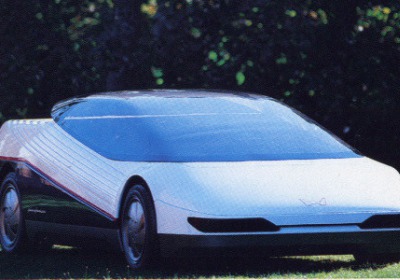Concept Car of the Week: Honda HP-X (1984)
Fri, 01 Mar 201320 years after producing its first production car, Honda grew enough confidence to challenge European sports cars on their own turf. Going straight for the jugular, they commissioned the famous Italian carrozeria Pininfarina to design a mid-engined two-seater concept for the 1984 Turin Motor show.
The HP-X, standing for Honda Pininfarina eXperimental, had a very clean composition divided in three distinct elements: the matte black lower, the white ribbed body and the completely transparent canopy on top. The nose is low and the headlamps have the typical robotic expression very popular in early ‘80s.
The ribs rise from the front wheel to become the louvers above the rear deck for engine cooling. A red accent follows the rising graphics and wraps around the back, integrating the tail lamps.
It seems the car was first sketched in side view as it works well from there but the transition to 3D appears a little less successful. Nevertheless, the simplicity of the volumes and graphics assure an overall timeless design.
One of the reasons why the HP-X looks so smooth is the absence of doors, resulting in no shutlines. Instead, the Perspex canopy opens like the cockpit of a jet fighter and is the only way inside the vehicle.
The canopy also extends behind the integrated roll bar to act as a roof spoiler. It is powered by a 2.0L V6 taken from the Honda Legend, which produces a rather underwhelming 143bhp. To compensate, the slippery Berlinetta has an impressive drag coefficient of just 0.25.
Inside, the dashboard is as minimalist as the exterior but the geometric design of the IP seems a little out-of-place and doesn't connect with the curvier exterior.
Motivated by the positive response from the public, the Japanese manufacturer further developed the idea of a rear engine sports car to beat the Western competition. The original target was the Ferrari 328 which was revised to the 348 as the project evolved. Therefore the anemic 2.0L was replaced by a more appropriate 270bhp 3.0L V6 VTEC.
The company also used its experience in Formula One racing and redesigned the entire suspension system, with the chassis being the first ever all-aluminum monocoque. In 1989, Honda was now ready to unleash its beast. The results would be revealed at the Chicago Auto Show under the name New Sports eXperimental, better known as the legendary NS-X.
Your author, Flavien Dachet, is a UK-based, French-born car designer. You may know him as the purveyor of KarzNshit, a photo blog that if isn't already in your bookmarks, certainly should be.
By Flavien Dachet



